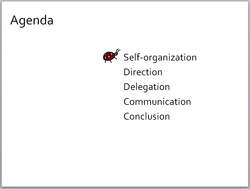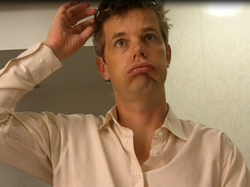…continued from part 1. Step 4: Define slides In this step I transform the topics…
How to Make a Presentation (part 3)
…continued from part 1 and part 2.
When I am confident about the content, structure and supporting materials, I start creating the slides. Note that rework of the content in slides is costly! That’s why I need to know what is going to be shown on which slide before I start making them.
At this time the details of the layout (font size, colors, positioning, etc) are not important. These are easy to do later.
What’s important in this step is that content, structure, and basic materials all have their right place in the presentation.
Step 8: Review the talk
This is the moment when I review the entire presentation to check if I have everything right. Are the stories in the right place? Do I have some silly jokes to entertain the audience? Do I have some surprises in there to keep them awake?
Basically it means I perform the entire presentation in my head to see if the flow is right. This review can result in some final tweaking of the content: splitting or merging slides, or adding/removing some.
Only now is the right time to bother with the layout, after I have verified that all content is in the right place. This means taking care of font, size, colors, positioning, etc.
Again, consistency is important. I don’t want to use 5 different sizes of fonts on my slides. That’s why the content must be finalized at this point, because the best decisions for a consistent layout depend on the whole set of texts and visuals.
(Oh, and one layout tip: please don't center everything on your slides. Stop that immediately. It's boring. You have two good friends for design: white space and alignment.)
The last step, and one of the most important ones, is to practice the presentation. I practice a new talk at least three times. The purpose is not to rehearse the texts until I know them by heart. I prefer being casual, and being able to respond to the audience. That means I don’t want to read from a script.
However, the purpose is to know the content, so that I’m not surprised by it myself. For example, only when speaking out loud I may realize that I don’t know how to pronounce a foreign word; or I realize that I must know the exact timing of a joke right before I show a slide that gives away the punch line.
My plea is never to go on stage if you have not rehearsed your performance. Music lovers expect artists to have practiced before they see them on stage. It is an insult to the audience if you think you can get away by not rehearsing your show.
That’s it. These are my 10 steps for making presentations. I hope you found them useful!
back to part 1 – back to part 2
p.s. You still have not ordered the book Presentation Zen, by Garr Reynolds? Well, then at least get yourself Confessions of a Public Speaker (Scott Berkun), or Slide:ology by (Nancy Duarte). Those ain’t bad either.
 Twitter –
Twitter –  Subscribe –
Subscribe –  Newsletter –
Newsletter –  LinkedIn –
LinkedIn –  SlideShare
SlideShare
| Latest, greatest and favoritest posts: No Maturity Models, But Individual Competence People Motivation: Target Intrinsic Desires Risk Management = Banana Peels AND Dollar Bills |







